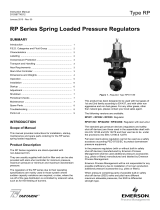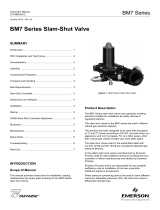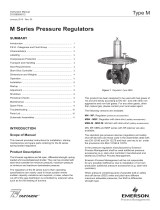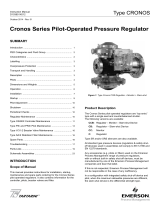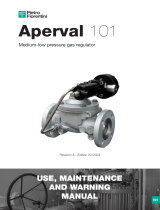Page is loading ...

CNF, CN, CF, and SV Series
Instruction Manual
D103668X012
October 2014 - Rev. 00
TM
CNF, CN, CF, and SV Series Heat Exchangers
Figure 1. Tube Bundle Heat Exchangers
SUMMARY
Introduction ........................................................................ 1
P.E.D. Categories and Characteristics .............................. 2
Labelling ............................................................................ 2
Transport and Handling ..................................................... 3
Preservation and Storage .................................................. 3
Atex Requirements ............................................................ 3
Operation ........................................................................... 3
Installation ......................................................................... 3
Startup and Shutdown ....................................................... 5
Maintenance ...................................................................... 5
Spare parts ........................................................................ 5
Parts List ............................................................................ 6
Schematic Assemblies ....................................................... 6
INTRODUCTION
Scope of Manual
This manual provides instructions for installation, startup,
maintenance and spare parts ordering for the CNF, CN, CF,
and SV Series heat exchangers.
Product Description
In the gas pressure reduction process by the
“Joule-Thomson” effect, temperature drops considerably
(about 0.5°C per reduction bar are estimated). This fall in
gas temperature can damage equipment due to formation of
dangerous ice crystals produced by water vapor in the gas.
In rst stage stations in particular, gas must be heated
before pressure is reduced, since high pressure changes
are usually involved. We recommend that, after reduction,
gas temperature should not be below 5°C. One of the best
established methods of heating gas in reduction stations is
to use heat exchangers employing hot water or steam as
their thermal carrier uid.
The heat exchangers we produce are sized and designed to
meet a very wide range of system requirements.
This product has been designed to be used with fuel gases of
1st and 2nd family according to EN 437, and with other non
aggressive and non fuel gases. For any other gases, other
than natural gas, please contact your local sales agent.

CNF, CN, CF, and SV Series
2
P.E.D. CATEGORIES
AND CHARACTERISTICS
P.E.D. Categories and Fluid Group
Table 1. P.E.D. Categories and Fluid Group
TYPE CATEGORY
FLUID
GROUP
CNF-05-AP
Thermal
carrier uid:
Water
Standard
Temperature
Version
III 1
Low
Temperature
Version
CNF-1-AP
CN2-AP
CNF2-AP
CF3-AP
CF1-AP/5000
CF1-AP/8000
CF1-AP/12500
CF1-AP/17500
Standard
Temperature
Version
IV 1
Low
Temperature
Version
SV (all type)
Thermal
carrier uid:
Steam
Standard
Temperature
Version
Low
Temperature
Version
Characteristics
Table 2. CNF, CN, and CF Series Maximum Nozzles Diameter
Gas Side Flanged ANSI (150 on request) 300/600
Water Side Flanged PN 6 - 16
TYPE MAX DN GAS SIDE MAX DN WATER SIDE
CNF-05-AP 50 50
CNF-1-AP 100 65
CN2-AP 125 80
CF2-AP 125 80
CF3-AP 150 80
CF1-AP/5000 200 80
CF1-AP/8000 250 80
CF1-AP/12500 300 150
CF1-AP/17500 350 200
Table 3. SV Series Maximum Nozzles Diameter
Gas Side Flanged ANSI 300/600
Steam Side Flanged PN 6 - 16
TYPE MAX DN GAS SIDE MAX DN WATER SIDE
SV3-AP 125 80
SV-AP/5000 150 80
SV-AP/8000 200 80
SV-AP/12500 250 125
!
WARNING
Table 4. Specications
TYPE
RATING
GAS SIDE
MAXIMUM
WORKING
PRESSURE
bar
MAXIMUM ALLOWABLE
PRESSURE (PS) bar
Tube Side Shell Side
CNF - CN - CF
ANSI 300 17 30
5
ANSI 600 75 85/90
SV
ANSI 300 17 30
5
(12 on request)
ANSI 600 75 85/90
Minimum/Maximum Allowable Temperature (TS)
CNF, CN, and CF Series
Standard Version: -10°/100°C
Low Temperature Version: -20°/100°C
SV Series
Standard Version: -10°/160°C
Low Temperature Version: -20°/160°C
The pressure/temperature limits in this Instruction Manual
and any applicable standard or code limitation should not
be exceeded.
LABELLING
BOLOGNA ITALY
1370
body
Notified
Note 1
Note 2
Note 3
Note 4
Note 3
Note 4
Note 6Note 6
Note 5
Note 5
Note 5
Note 5
DATA:
DATE:
TUBE SIDE
LATO MANTELLO
SHELL SIDE
LATO TUBI
RADIOGRAFIA SALDATURE/RADIOGRAFY OF THE WELD
CAPACITA'/CAPACITY
EFFICIENZA SALDATURE/EFFICIENCY OF THE WELD
ATTACCHI A FLANGIA
FLANGE CONNECTION
IN USCITA
OUTLET
IN ENTRATA
INLET
DN
DN
PN
ANSI
ANSI
PN
LATO TUBI
TUBE SIDE
LATO MANTELLO
SHELL SIDE
Note 5
Note 5
Note 5
Note 5
PN
ANSI
ANSI
PN
TIPO: N° FABBR.
SERIAL N°TYPE:
DN
DN
PN MPa
PN Bar
PT Bar
PT MPa
FLUIDO GRUPPO/GROUP FLUID
( TEMP.DI PROGETTO/DESIGN TEMPERATURE ) TS °C
( PRESSIONE DI PROGETTO/DESIGN PRESSURE )
PS Bar
PS MPa
PESO/WEIGHT Kg
(PROVA IDRAULICA/HYDRAULIC TEST)
(PROVA PNEUMATICA/PNEUMATIC TEST)
(SUPERFICE DI SCAMBIO TERMICO/HEATING SURFACE) m
2
l
Figure 2. Label for Heat Exchangers
Note 1: See “Characteristics”
Note 2: Year of manufacture
Note 3: Tube Side
Maximum PS = 90 bar
Shell Side
Maximum PS = 5 bar (SV Series 12 bar on request)
Note 4:
CNF, CN, and CF Series
Standard Temperature Range: -10°/100 °C
Low Temperature Range: -20°/100 °C
SV
Series
Standard Temperature Range: -10°/160 °C
Low Temperature Range: -20°/160 °C
Note 5: Available with different ange ratings,
see “Characteristics”
Note 6: PT = 1.5 x PS bar

CNF, CN, CF, and SV Series
3
TRANSPORT AND HANDLING
The equipment is self stiffened and standard lifting devices
may be used for handling and erection. Since these units will
be supplied with all surfaces painted, it is recommended the
use of proper protection to avoid paint damage.
Stand-alone equipment is delivered either in horizontal or
vertical position standing on saddles or on cage. Handling
and erection has to be done using the proper lifting devices
attached on lifting points. During this lifting operation avoid
to use inlet/outlet nozzles of water and gas sides shall not
be hooked.
Transport saddles, if any, are connected to the equipment
by straps or steel ropes; during handling those are to be
checked to avoid accidental saddle disconnection.
Eyebolt can be used only for water/steam side shell’s lifting
and not for whole equipment lifting.
PRESERVATION AND STORAGE
Stand-alone equipment is delivered with all nozzles blanked
and all surfaces completely protected by primer or paint
(carbon steel material versions). hence the equipment
doesn’t need specic precautions for storage, providing to
follow the recommendations listed in “Inspection” section on
page 4 of this Instruction Manual.
ATEX REQUIREMENTS
!
WARNING
If the provisions of EN 12186 & EN 12279,
national regulations, if any, and specic
manufacturer recommendations are not
put into practice before installation and
if purge by inert gas is not carried out
before equipment’s start-up and shut-down
operations, a potential external and internal
explosive atmosphere can be present in
equipment & gas pressure regulating/
measuring stations/installations.
If a presence of foreign material in the pipelines is foreseen
and purge by inert gas is not carried out, the following
procedure is recommended to avoid any possible external
ignition source inside the equipment due to mechanical
generated sparks:
• drainage to safe area via drain lines of foreign materials, if
any, by inow of fuel gas with low velocity in the pipe-work
(5m/sec)
In any case,
• provisions of Directive 1999/92/EC and 89/655/EC shall
be enforced by gas pressure regulating/measuring station/
installation’s end user
• with a view to preventing and providing protection against
explosions, technical and/or organizational measures
appropriate to the nature of the operation shall be taken
(e.g. : lling/exhausting of fuel gas of internal volume
of the isolated part/entire installation with vent lines
to safe area - 7.5.2 of EN 12186 & 7.4 of EN 12279 ;
monitoring of settings with further exhaust of fuel gas to
safe area ; connection of isolated part/entire installation to
downstream pipeline; ….)
• provision in 9.3 of EN 12186 & 12279 shall be enforced by
pressure regulating/measuring station/installation’s end user
• external tightness test shall be carried out after each
reassembly at installation site using testing pressure in
accordance with national rules
• periodical check/maintenance for surveillance shall be
carried out complying with national regulations, if any, and
specic manufacturer recommendations.
OPERATION
Equipment operating at high pressure should be warmed up
slowly and uniformly before applying full pressure.
Pressure should be increase in stages of approximately 10%
of operating pressure up to the operating value.
In case of leakage or other inconvenience, the procedure
should be immediately stopped and the problem investigated
and removed before a new startup.
INSTALLATION
!
WARNING
Only qualied personnel shall install an
Heater exchanger. Heater exchangers should
be installed, operated and maintained in ac-
cordance with international and applicable
codes and regulations. Following notes and
instructions point out, in particular, the “pres
-
sure” risk. Installation, operation and mainte-
nance procedures performed by unqualied
personnel may result in unsafe operation.
This condition may result in equipment
damage or personal injury. If a leak develops
in the system, the escaping gas may
accumulate and become a re or explosion
hazard. Immediately call qualied service
personnel in case of trouble.
Hazards arising from misuse and
misoperating are: Personal injury, equipment
damage, or leakage due to escaping gas or
bursting of pressure-containing parts may
result if the equipment is installed where its
capabilities (PS and TS) can be exceeded or
where conditions exceed any ratings of the
adjacent piping or piping connections.

CNF, CN, CF, and SV Series
4
To avoid this, install the equipment where:
• Service conditions are within unit capabilities.
• Service conditions are within applicable codes,
regulations, or standard.
• The unit is protected from exposure to physical damage
and/or corrosive substances.
• Suitable pressure-limiting or pressure-relieving devices
have been installed in those instances where supply
pressure is capable of exceeding the maximum allowable
downstream equipment pressure.
National safety standards and established rules shall be
applied in heater exchanger installation and operation,
concerning, in particular, electrical works, re, and
thunderbolt protection.
All means for venting have to be provided in the assemblies
where the pressure equipment are installed.
Before installation, check shall be done if service conditions
are consistent with use limitations.
Where this product is used:
• provide the cathodic protection and electrical isolation to
avoid any corrosion
• the gas shall be cleaned by proper lters/separators/
scrubbers to avoid any technical & reasonable hazard of
erosion or abrasion for pressure-containing parts.
Heat exchangers shall be installed in non-seismic area and
hasn’t to undergo re and thunderbolt action.
Inspection
Upon arrival at site the equipment must be inspected for
eventual damages occurred during transportation. At least,
the following points have to be inspected:
• Integrity of nozzles closure and equipment sealing.
• Status of painted surfaces. If paint is damage any touch-
up shall be carried out in accordance with the project
coating specication.
• Visual check of critical areas such as nozzles, saddles, clips.
Any damage shall be reported to quality control ofce and
eventually to the vendor in order to agree and coordinate
any repair work.
The heat exchanger have been subject to hydrostatic
test at our factory according to Code and Specications
requirements and thoroughly inspected for leakage during
the above test.
However, handling during transportation or moving into place
may have loose gasketed seals: based upon the above, it is
recommended to recheck all bolted connections, if any, prior
to startup.
Cleaning
Thoroughly clean and blow all pipe lines to remove scales
and other possible foreign material.
Piping Up
The piping established practice shall be follow when
installing the heater exchanger. The heater exchanger must
be installed with the ow as indicated by the in and out
marking on the heater exchanger itself.
Foundations
Foundation or metallic supports should be suitable to support
the equipment and its maximum contents, which may result
in stresses caused also by piping connections.
Levelling
The heat exchanger should be installed to the correct level
within the limits agreed by Data Sheet or specications.
Access
The heat exchanger should be installed with sufcient
clearance from associated structures and equipment to
provide safe, efcient working by operators and to provide
ready access for cleaning, inspection and maintenance.
The heat exchanger is designed with removable tube bundle
after disassembly of the channel in order to permit an
internal inspection (when required): so, the heat exchanger
shall be installed with sufcient space in front of it (at least
the length of the tube bundle).
Support should be so arranged to provide adequate
movement around the equipment.
Flanged and Bolted Joints
Accurate vertical and horizontal alignment, with ange faces
parallel, is an important precaution to be taken when making
up a anged joint.
A suggested bolt tightening sequence is to process “three
o’clock, nine o’clock, twelve o’clock, six o’clock, etc.”
After have complete the above sequence and additional
check have to be performed on all bolts. The same procedure
has to be followed in case of maintenance.
Piping and Connections
To avoid excessive stresses or strains due to piping
connections, the following precautions should be taken:
• To avoid stresses arising from nozzle connection, piping
should not be forced into alignment when connecting up.
• If the magnitude and direction of external piping forces
and moments are known and the nozzles have been
designed specically to these reactions, the above forces
and moments are not be exceeded.

CNF, CN, CF, and SV Series
5
Ventilation
Equipment should have adequate ventilation around them,
particularly where heat exchangers are located indoors.
The ventilation requirements should take into account the
type of medium which may escape from the equipment.
Special requirements for lethal material should be agreed
with the Authority involved.
Lighting
Where necessary, the illumination level of lighting at the
equipment should be sufcient to allow free movement
of operating personnel in safety while in operation under
normal conditions.
Shipping Covers and Plugs
The shipping covers and plugs (if any) should remain in place
until equipment is set in position and ready for piping up.
All openings should be inspected for debris or foreign
material that could damage the equipment.
STARTUP AND SHUTDOWN
Heat exchanger is particular sensitive to pressure increase
very rapidly since the tube bundle may be damage.
Pressure should be increase in stages of approximately 10%
of operating pressure up to the operating value.
In case of leakage or other inconvenience, the procedure
should be immediately stopped and the problem investigated
and removed before a new start-up.
!
WARNING
During start-up phase of heat exchangers
with Low Temperature shell versions (-20 °C),
to avoid any possible risk of brittle fracture
of tube bundle, hot water (or steam) ow
must be activated BEFORE increasing of gas
side pressure (ref. : PED Directive Annex I –
clause 4.1 and 7.5 ; PED Guideline 7/17).
Gasketed Connections
Before start-up and after initial start-up, at normal operating
pressure and temperature, it is recommended to inspect all
gasketed joints for tightness.
Shutting Down
When possible, reduce slowly the pressure in order to avoid
damage.
In no case open the equipment before the pressure is
completely released.
MAINTENANCE
Heater exchanger parts are subject to normal wear and must
be inspected periodically and replace as necessary.
The frequency of inspection and replacement depends upon
the severity of service condition and upon applicable codes
and government regulation.
During the inspection of the heater exchanger, the
equipment with drain valves, these shall be checked that the
valves are free of any debris that may restrict the drain ow.
In order to avoid personal injury or equipment damage
caused by sudden release of pressure or explosion of
accumulate gas, do not attempt any maintenance or
disassembly without rst isolating the heater exchanger from
system pressure and relieving all internal pressure from the
heater exchanger.
Before starting disassembly, carefully release all pressures
from the heater exchanger.
• Never loosen the heater exchanger body while the unit
is under pressure.
• Do not remove any pipe plugs from the unit while it is
under pressure.
• Use a gauge to monitor pressure while releasing it.
• The drain valve is for releasing uid. Direct the ow
stream in a safe direction.
SPARE PARTS
Spare parts storage shall be done by proper procedures according
to national standard/rules to avoid over aging or any damage.

CNF, CN, CF, and SV Series
6
SCHEMATIC ASSEMBLIES
Figure 3. Tube Bundle Assembly
PARTS LIST
Key Description
1 Head gas side
2 Shell gas side
3 Nozzle gas side
4 Flange gas side
5 Drain
6 Bafe separator
7 Shell ange gas side
8 Tube plate
9 Shell ange water side
10 Nut
11 Bolting
12 Fitting
13 Shell water side
14 Bafe
15 Tube bundle
16 Flange water side
17 Nozzle water side
18 Eyebolt
19 Fitting
20 Head water side
21 Thredolet
22* O-ring
23 Spacing
24 Nut
25 Washer
26 Bolting
(*) Spare parts.
To order the spare parts it is necessary to communicate to us the type of
the heat exchanger and its serial number.
18
19
20
24
25 26
23
17
16
21
10
11
22
12
13
14
15
16
17
9
8
7
4
4
33
6
5
5
1
2

CNF, CN, CF, and SV Series
7
Figure 4. Tube Bundle Disassembly

CNF, CN, CF, and SV Series
The Emerson logo is a trademark and service mark of Emerson Electric Co. All other marks are the property of their prospective owners. Tartarini is a mark of O.M.T. Ofcina Meccanica Tartarini s.r.l.,
a business of Emerson Process Management.
The contents of this publication are presented for informational purposes only, and while every effort has been made to ensure their accuracy, they are not to be construed as warranties or guarantees,
express or implied, regarding the products or services described herein or their use or applicability. We reserve the right to modify or improve the designs or specications of such products at any
time without notice.
Emerson Process Management Regulator Technologies, Inc., does not assume responsibility for the selection, use or maintenance of any product. Responsibility for proper selection, use and
maintenance of any Emerson Process Management Regulator Technologies, Inc., product remains solely with the purchaser.
©Emerson Process Management Regulator Technologies, Inc., 2014; All Rights Reserved
Industrial Regulators
Emerson Process Management
Regulator Technologies, Inc.
USA - Headquarters
McKinney, Texas 75070, USA
Tel: +1 800 558 5853
Outside U.S. +1 972 548 3574
Asia-Pacic
Shanghai 201206, China
Tel: +86 21 2892 9000
Europe
Bologna 40013, Italy
Tel: +39 051 419 0611
Middle East and Africa
Dubai, United Arab Emirates
Tel: +971 4811 8100
For further information visit www.emersonprocess.com/regulators
Natural Gas Technologies
Emerson Process Management
Regulator Technologies, Inc.
USA - Headquarters
McKinney, Texas 75070, USA
Tel: +1 800 558 5853
Outside U.S. +1 972 548 3574
Asia-Pacic
Singapore 128461, Singapore
Tel: +65 6777 8337
Europe
O.M.T. Tartarini s.r.l. Via P. Fabbri 1,
I-40013 Castel Maggiore (Bologna), Italy
Tel: +39 051 419 0611
Francel SAS, 3 ave Victor Hugo,
CS 80125 - Chartres 28008, France
Tel: +33 2 37 33 47 00
Middle East and Africa
Dubai, United Arab Emirates
Tel: +971 4811 8100
TESCOM
Emerson Process Management
Tescom Corporation
USA - Headquarters
Elk River, Minnesota 55330-2445, USA
Tels: +1 763 241 3238
+1 800 447 1250
Asia-Pacic
Shangai 201206, China
Tel: +86 21 2892 9499
Europe
Selmsdorf 23923, Germany
Tel: +49 38823 31 287
O.M.T. Ofcina Meccanica Tartarini S.R.L., R.E.A 184221 BO Cod. Fisc. 00623720372 Part. IVA 00519501209 N° IVA CEE IT 00519501209,
Cap. Soc. 1.548 000 Euro i.v. R.I. 00623720372 - M BO 020330
Francel SAS, SIRET 552 068 637 00057 APE 2651B, N° TVA : FR84552068637, RCS Chartres B 552 068 637, SAS capital 534 400 Euro
/




